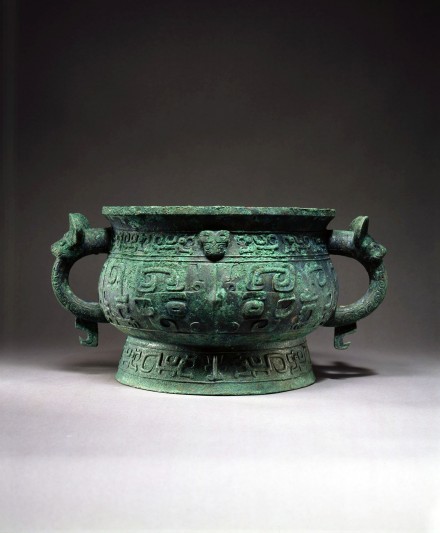J.J. Lally & Co., Oriental Art / New York City, New York
MenuPast Exhibition
Bronze and Gold in Ancient China
March 24 - April 12, 2003

7.
A MASSIVE BRONZE RITUAL FOOD VESSEL (GUI)
Early Western Zhou Period, 11th/10th Century B.C.
well cast in high rounded relief with two large taotie masks, each with protruding oval eyes under horizontal 'C'-scroll horns on either side of a broad ridged nose rising to a point in the center, with hooked scroll-form tails and talons extending out on either side to complete the disintegrated bodies of the pair of profile kui dragons which together make up the taotie mask, and with small descending kui dragons flanking the thick loop handles issuing from bovine masks with high rounded horns, cast with intaglio scroll decoration on the sides of the handles above hooked tabs, the rounded sides of the deep bowl raised on a high flaring foot encircled by a band of four pairs of profile kui dragons centered on shallow flanges, and with a collar of twelve more profile kui dragons in groups of three confronting raised animal masks below the thick everted rim, with a single pictogram cast in the center of the interior, the dark bronze with widely scattered malachite green encrustation over all.
Width over handles 15 inches (38.1 cm)
A large bronze gui of very similar form cast with the same decoration on the sides and handles, and cast with a pictogram which may be read as "tian" (heaven) on the interior base, was excavated at the Shang and Zhou cemetery in Zhangjiayuan village, Jixian county, Tianjin province in 1987, and is illustrated in the catalogue of the special exhibition entitled Zhongguo Wenwu Qinghua (Gems of China’s Cultural Relics), Beijing, 1997, no. 53, and now is in the collection of the History Museum of Tianjin.
7.
A MASSIVE BRONZE RITUAL FOOD VESSEL (GUI)
Early Western Zhou Period, 11th/10th Century B.C.
Width over handles 15 inches (38.1 cm)